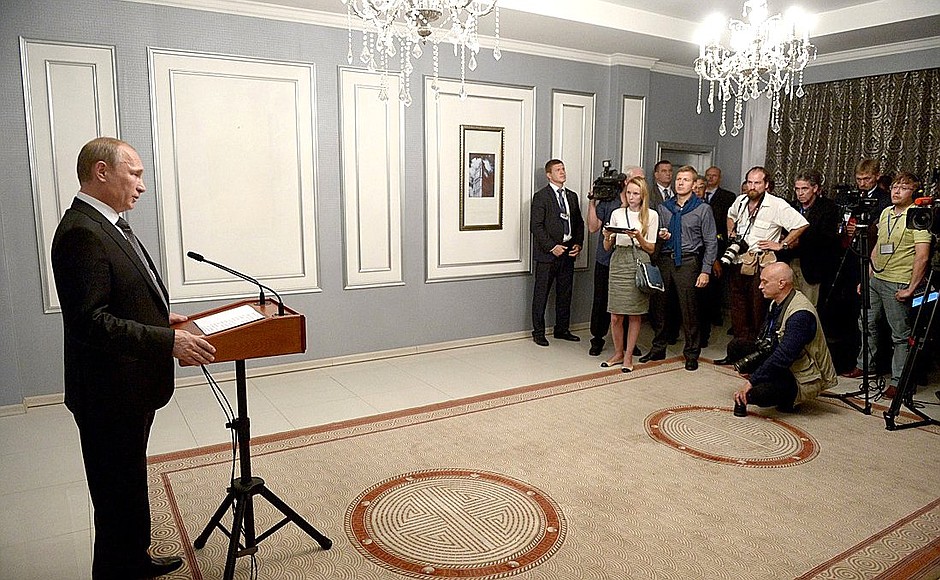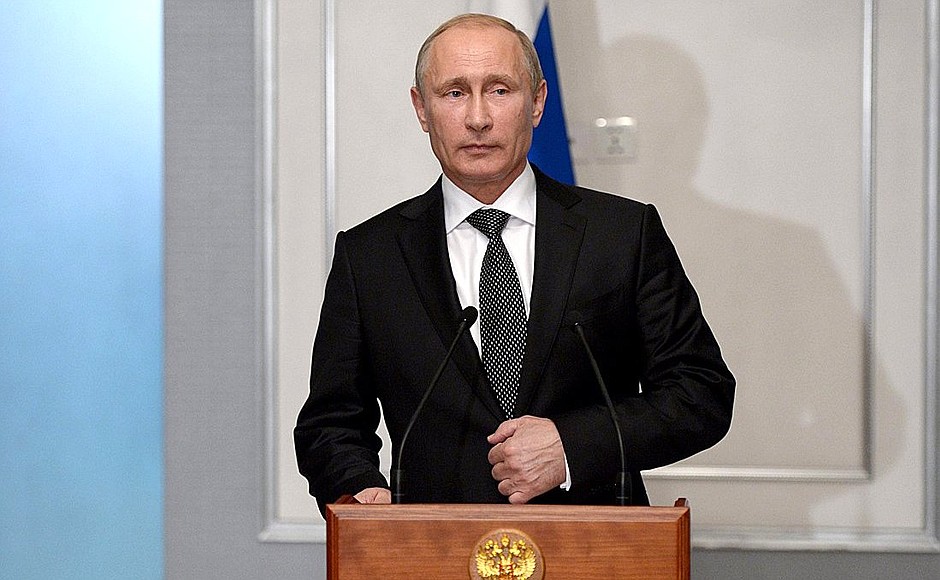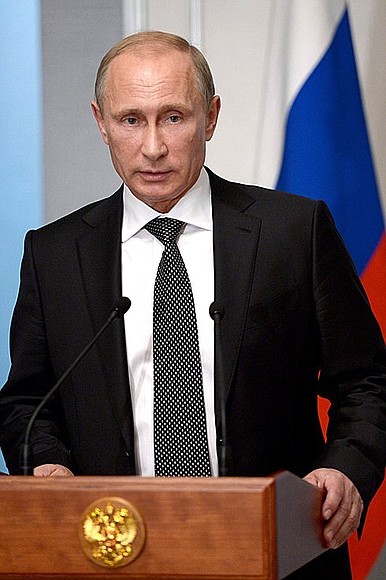Question: Since we are here in Mongolia, I would like to ask about the visit’s results and whether you have managed to overcome the inertia in our trade and economic relations.
President of Russia Vladimir Putin: Yes, we talked a lot today about our trade and economic ties, although, as you know, this visit was timed to coincide with an event of a different nature – the 75th anniversary of the battle at Khalkin-Gol. This is a big event in our common history.
But of course we had to seize the opportunity too to discuss the full range of our relations, which we did, and, as I said during our work today, our colleagues from the various ministries, agencies, and companies representing the main areas of our cooperation did some very good work.
One of these areas is transport. This is a very important sector for Mongolia, and it is in our interests too to increase Mongolia’s transit potential. Mongolia is located between Russia and China after all. We are big trade and economic partners and have bilateral trade with China that will come to $64 or already 65–67 billion this year. It therefore makes sense to put Mongolia’s transport possibilities to greater use than is the case today. Then there is the metals sector, which was inherited from the Soviet period and is developing actively.
But there are clear problems too, arising due to the big imbalance in our trade relations. In this respect we are working now on increasing supplies of produce to Russia, but this is a case of our partners asking us to do this too. Some restrictions on supplies of animal products had been imposed earlier, but we have agreed that the Russian Federation Government will examine the matter of lifting these restrictions, especially those concerning meat supply quotas.
So we have transport, the metals sector, infrastructure development, and agriculture, and we discussed all of these sectors in quite some depth. We do have a concrete action plan but it has not yet been drafted on paper. We will need to complete this work soon.
Investment continues, but it is very clear that this is still not enough. Work on investment is another component of our cooperation and I think that there are good prospects in this area too.
Overall, I am happy with the results of today’s work.
Question: Mr President, you spoke with Mr Poroshenko today. The Ukrainian authorities initially announced that you had agreed on a complete ceasefire, but then explanations came that what is under discussion are concrete steps for settling the situation, which is understandable, given that Russia is not a party to this conflict. If there was discussion of concrete steps, what are they, and what will happen next?
Vladimir Putin: Yes, I did speak with President Poroshenko this morning, and it seemed to me at any rate that our views on how to settle the conflict are very close, as the diplomats say.
On the way here from Blagoveshchensk to Ulan Bator, I jotted down a few thoughts that could constitute an action plan of sorts. True, I have only these notes that I jotted down, but I can read them to you if you want.
In order to stop the bloodshed and stabilise the situation in southeast Ukraine, I believe that the parties to the conflict should immediately agree on and coordinate the following steps:
First, end active offensive operations by armed forces, armed units and militia groups in southeast Ukraine in the Donetsk and Lugansk areas.
Second, withdraw Ukrainian armed forces units to a distance that would make it impossible to fire on populated areas using artillery and all types of multiple launch rocket systems.
Third, allow for full and objective international monitoring of compliance with the ceasefire and monitoring of the situation in the safe zone created by the ceasefire.
Fourth, exclude all use of military aircraft against civilians and populated areas in the conflict zone.
Fifth, organise the exchange of individuals detained by force on an ‘all for all’ basis without any preconditions.
Sixth, open humanitarian corridors for refugees and for delivering humanitarian cargoes to towns and populated areas in Donbass – Donetsk and Lugansk Regions.
Seventh, make it possible for repair brigades to come to damaged settlements in the Donbass region in order to repair and rebuild social facilities and life-supporting infrastructure and help the region to prepare for the winter.
I think that the Kiev authorities and the representatives of southeast Ukraine could come to basic agreements and cement them at the contact group’s planned meeting on September 5.
I want to note that this statement and all I just said follow on from the telephone conversation with President Poroshenko that you asked about. I hope very much that Ukraine’s government will support the emerging progress in bilateral relations and make use of the positive opportunity the contact group’s work provides to bring about final and comprehensive settlement to the situation in southeast Ukraine, in full and unconditional respect for the lawful rights of those who live there of course.
That is all I have to say. I have nothing to add. Thank you.


